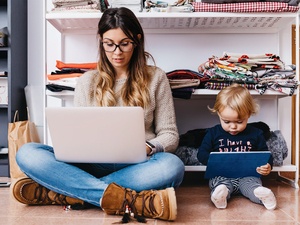Utah women in the workforce see negative effects from COVID-19
On Aug. 25, the members of the Utah Women & Leadership Project met to discuss the impact Covid-19 is having on women in the workforce.
Dr. Susan R. Madsen, the founder of this effort, hosted the meeting and addressed the concern for the employment rates of women in Utah.
“I believe that one of my life callings is to strengthen the impact of girls and women in this world — including in Utah, so I feel called to do this work,” Madsen said.
And although the pandemic has caused the economy and all types of workers to take a hit, this meeting showed that women seem to have taken it the worst.
Jobs were lost, education was disrupted, and everyday life at home became harder than ever before.
The meeting also specified that COVID-19 has affected working women in our surrounding communities more than most others. The unemployment rate for women during the pandemic nearly doubled the rate of working men.
To understand what women were facing, a survey was sent out in January 2021 to all women over the age of 20.
One of the questions from the in-depth survey asked, “If you are not currently working for pay or if you stopped working at any time after March 2020, what is/was your main reason for doing so?”
A common response from the women was that their employer had lost business and couldn’t afford to keep them hired.
Another major reason for the unemployment rate increasing is women having to leave work to take care of their children that were no longer able to go to school or daycare.
Taylor Pollock, a freshman at Utah State University, expressed the impact that COVID-19 had on her mother and family.
“My mom is a licensed cosmetologist and a master esthetician,” Pollock said. “She works at a day spa and at some point, during Covid, she was not deemed an essential business so she had to stop working. Luckily for us, we live with our grandma, so we weren’t kicked out of our house.”
Pollock also said there was more tension present in her home when everybody was stuck inside all the time.
This ripple effect from the pandemic also led numerous mothers, chiefly single mothers, to experience various mental health problems.
On the flip side, there were women working harder than they ever had during the pandemic but their efforts didn’t match their wages.
For example, those who worked for food services and those in the medical field saw a massive increase in workload without much relief or reward. This resulted in many women feeling burnt out at the end of the day, especially those who have young children at home.
But results show there were only a small percentage of women that felt overly concerned about money.
One potential reason for this could be because this past January, women were able to get back on their feet and receive support from the CARES act and other resources.
Madsen expressed that efforts are still continuing and that companies are making an effort to support workers — especially women.
“There have been back to work learn and work programs through COVID-19 to help people retool and learn to shift careers/jobs,” she said. “COVID funds have been around during part of it to keep childcare facilities and providers open to take children.”
Some of these efforts include allowing flexibility in work location and hours. Free mental health counseling has also been provided and paid sick leave for many employees was increased.
Brielle.carr@usu.edu

